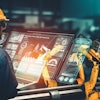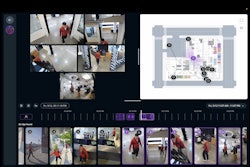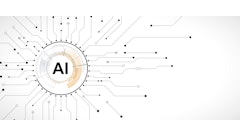
From climate volatility to raw materials shortages and cyberattacks, supply chain disruptions have turned yesterday’s lean networks into permanent high‑risk zones.
A 2024 McKinsey survey found 73% of supply chain leaders are now dual‑sourcing critical SKUs and 60% are regionalizing footprints. Yet most still lack the real-time intelligence needed to act when the next canal blockage, chipset shortage, or data center failure hits.
The new goal is antifragility — networks that learn from disruption, reroute automatically, and come back stronger.
Six AI-enabled capabilities are making this possible, with impacts across all phases of the supply chain: upstream inputs, core manufacturing processes, and downstream outputs. With a strategic, intentional implementation plan, your organization can harness these powerful capabilities, too.
6 AI capabilities transforming connected supply chains
To build true antifragility, organizations must go beyond dashboards and deploy AI where it matters most — at the operational core. The following innovations are redefining how resilient, responsive networks are built:
1. Smart procurement and inventory intelligence
Upstream inefficiencies like overstocked raw materials or delayed supplier responses create ripple effects throughout the value chain. AI-driven procurement platforms mitigate these risks with predictive insights and proactive sourcing strategies.
For example, they can evaluate supplier performance, price volatility, lead times, and geopolitical risks to recommend optimal vendors and order schedules. Some automotive manufacturers use AI to forecast demand for steel or semiconductors and dynamically adjust order volumes based on real-time shifts in customer orders or macroeconomic indicators.
In parallel, intelligent inventory planning powered by AI helps determine when to apply just-in-time (JIT) approaches or just-in-case (JIC) approaches based on market volatility, lead times, and customer expectations. For example, a consumer electronics company that imports batteries from Southeast Asia might rely on AI to increase buffer stock in warehouses automatically whenever typhoon season puts shipping lanes at risk.
2. Self-healing digital twins in intelligent manufacturing and downstream logistics
Digital twins are full‑fidelity, cloud‑based replicas of production environments, plants, ports, and distribution nodes. AI enables these systems to run thousands of “what‑if” permutations per hour, continuously updating with IoT streams and external risk signals.
In smart factories, digital twins are driving the radical transformation of manufacturing floors. They enable AI to evaluate shift schedules, machine utilization, material flow, and even energy usage to manage everything from machine health to production flow optimization. Manufacturers like Siemens are using AI-infused twins to test hundreds of production variations before physical implementation, accelerating product development and minimizing downtime.
Moreover, AI-enabled visual inspection systems detect defects in real time with greater accuracy than human inspectors, while AI-powered predictive maintenance helps avoid costly machine failures. Together, these process innovations enable manufacturers to reduce waste, increase throughput, and enhance overall operational agility.
In downstream logistics, these advanced systems move planning from monthly S&OP cycles to minute‑level decision loops, enabling increased efficiency and supply chain responsiveness.
3. AI-enhanced demand forecasting
Models that predict SKU‑level demand by zip code can determine ideal “ship‑from” locations before a purchase is placed. For example, AI-powered demand forecasting that integrates diverse data sources -- from IoT devices and customer interactions to weather reports and social media trends — to enhance inventory accuracy and improve regional forecasts. This holistic approach helps reduce costs, speed up operations, and elevate the customer experience.
By incorporating real-time analytics and location-specific data, these systems enable agility and in-the-moment supply chain optimization.
4. “Agentic” warehouse automation
AI-enabled, autonomous mobile robots understand natural language commands and solve problems independently. This allows them to make context-aware decisions and collaborate with human and digital agents in warehouse settings.
For example, agentic warehouse robots that locate parts on command, navigate tight spaces, and quickly learn new tasks. In the future, robots will be part of multi-agent AI systems that trigger actions automatically, without human input. More versatile robots streamline warehouse operations, ultimately accelerating deliveries and reducing costs.
5. AI-augmented control towers
AI-augmented control towers leverage cloud platforms that process real-time data — from telematics and satellite feeds to social chatter — and prescribe actions like re-sequencing loads, pre-booking capacity, or injecting inventory on the fly.
For example, a Virtual Ocean Control Tower that leverages predictive analytics and machine learning to flag risks like port congestion and temperature deviation in near-real-time.
As a result, shippers move from rearview visibility to early‑warning orchestration across tiers.
6. Autonomous cyber-resilience
With every container, forklift, and sensor now a potential attack surface, AI-driven cyber-resilience is essential. Advanced models monitor OT/IT traffic for anomalies, automatically isolate infected devices, and self-patch edge nodes, stopping malware before it spreads across the supply chain. These “self-healing business networks” localize threats and reroute workflows in real time, minimizing disruption and downtime.
The AI implementation playbook
The key to AI rollout success is to dream big but start small. Launch pilot programs to build proof of concept, then scale as results become clear.
● Build a data foundation. AI is only as effective as the data it’s trained on. To ensure data quality, consolidate demand, supply, and risk signals in a data lakehouse, then deploy a graph to map multi‑tier dependencies. With an end-to-end SKU genealogy in place, you should achieve a 10% lift in forecast accuracy even without further steps.
● Stand up a digital twin. Define a narrow scope to start. For example, you could build a digital twin of a single smart factory or warehouse facility, or focus on your top 50 SKUs. Aim to rebalance inventory buffers and reduce scenario run-time within 90 days.
● Pilot agentic AI. Embed generative‑AI copilots into planning, production, and customer‑service flows to automate high‑volume workflows such as advanced shipping notices (ASNs). Track KPIs and iterate until you deliver a measurable productivity boost.
● Scale out autonomy. With a solid foundation in place, the sky’s the limit. Expand twin coverage to more SKUs and locations, enable closed‑loop orchestration with robotics/IoT, and layer in AI cyber‑defense. Impacts can include significant reductions in premium freight and order-cycle time.
● Orchestrate AI across systems. To achieve true supply chain antifragility, organizations must integrate AI across input, process, and output — not in silos, but as a unified system. This means combining supplier intelligence, smart factory operations, and downstream logistics under a single AI-enabled architecture.
An autonomous supply chain is a resilient supply chain
As disruption becomes the norm, the C‑suite mandate is clear: move beyond patchwork fixes and invest in AI that anticipates, acts, and adapts at machine speed.
It’s not just about optimizing the last mile of the supply chain, either. By embedding intelligence at every stage — sourcing, production, and delivery — leaders can respond to disruptions not with panic, but with precision.
Early adopters are already unlocking gains in service levels, inventory turns, and workforce productivity. But leaders who act now will gain more than speed and savings — they’ll build networks that learn, adapt, and even improve under stress. Waiting for stability isn’t a plan, it’s a liability. The winners will adapt to uncertainty by investing in AI and letting their supply chains think for themselves.



















